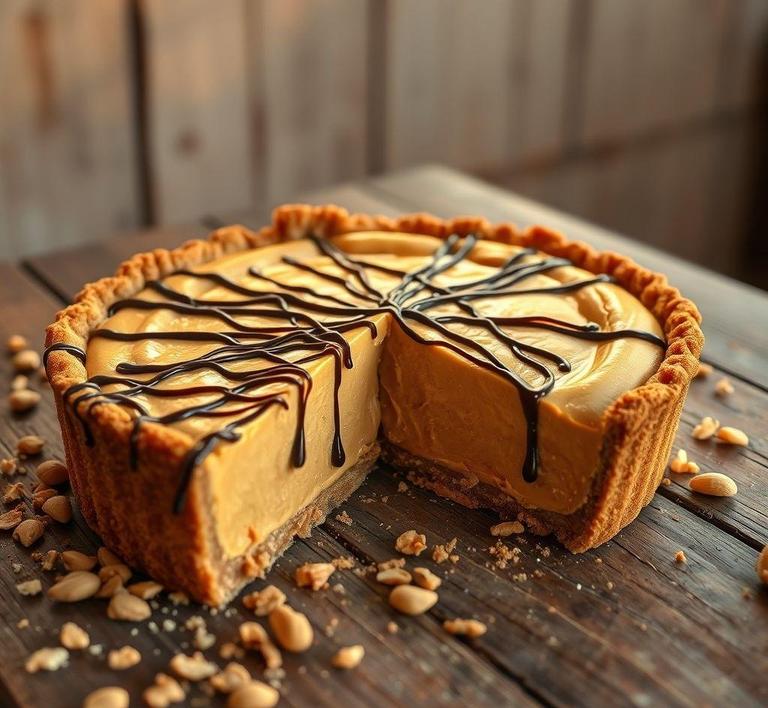If you’ve ever made or bought a peanut butter pie and found yourself with leftovers, you might be wondering if it’s possible to refreeze it without compromising its creamy, dreamy texture. The good news is, you absolutely can! Refreezing peanut butter pie can be a great way to preserve that rich, decadent flavor for later, but there are a few key tips and tricks to ensure it doesn’t lose its charm when you take it out of the freezer. In this guide, we’ll walk you through the best methods for refreezing your peanut butter pie and how to thaw it properly, so you can enjoy that sweet, nutty goodness whenever you’re in the mood!
Can You Refreeze Peanut Butter Pie?

Yes, you can refreeze peanut butter pie, but with a few important caveats. The ability to refreeze this indulgent dessert depends primarily on how it was handled after its initial thawing. If the pie was left out at room temperature for more than two hours-or one hour if the environment was particularly warm (above 90°F/32°C)-refreezing is not recommended due to the risk of bacterial growth. On the other hand, if the pie was thawed in the refrigerator and has remained chilled, you’re in a much safer zone for refreezing.
Peanut butter pie, particularly the no-bake variety, is typically made with ingredients like cream cheese, whipped topping, and peanut butter, all of which are sensitive to repeated temperature fluctuations. So while it is technically safe to refreeze under controlled conditions, it’s essential to consider the potential impact on texture and flavor.
How To Refreeze Peanut Butter Pie?
Refreezing this creamy dessert requires a little finesse to maintain as much of its original luscious texture as possible. Follow these detailed steps for best results:
-
Check the Pie’s Condition:
- Ensure it hasn’t been sitting at room temperature for too long.
- Check for any signs of spoilage, like an off smell or separation of ingredients.
-
Slice Before Freezing (Optional but Recommended):
- If you anticipate consuming the pie in smaller portions, slicing it before freezing allows you to thaw only what you need later, preventing repeated refreezing.
-
Wrap It Right:
- Use plastic wrap to tightly cover the pie (or individual slices), pressing the wrap gently against the surface to minimize air exposure.
- Then add an additional layer of aluminum foil or place the wrapped pie into a heavy-duty freezer bag or airtight container. This double-wrap method guards against freezer burn and flavor absorption.
-
Label and Freeze:
- Clearly mark the date and contents on the packaging. For optimal quality, refreeze and consume within 1 to 2 months.
Quality Impact
Refreezing peanut butter pie does not typically affect safety (if handled properly), but it can certainly impact quality. Let’s break it down:
-
Texture:
- The creamy filling of a peanut butter pie can become grainy or slightly separated after being thawed and frozen again. This is especially true for pies made with dairy-based components like cream cheese or whipped cream, which may not emulsify perfectly once thawed the second time.
- The crust, especially if made from crushed cookies or graham crackers, can become soggy or lose its crisp structure. Ice crystals formed during freezing can disrupt the structural integrity of both the filling and the base.
-
Flavor:
- Although flavor loss isn’t as drastic as texture degradation, there may be a slight dulling of the original peanut butter richness, especially if freezer odors are absorbed due to inadequate wrapping.
-
Appearance:
- You may notice some discoloration or minor separation upon thawing. This doesn’t mean the pie is bad, but it can affect presentation, especially if you’re serving it to guests.
While you can refreeze peanut butter pie safely under the right circumstances, the process isn’t without consequences. As a general rule of thumb, only refreeze the pie if it was thawed in the fridge and still looks and smells fresh. Proper wrapping and storage are critical to preserving its taste and texture.
That said, for optimal flavor and mouthfeel, it’s best to freeze the pie just once and enjoy it shortly after thawing. If you find yourself with extra pie, consider freezing it in individual slices to minimize waste and reduce the need for repeated freezing.
Ultimately, peanut butter pie is a dessert worth savoring in its prime-but with care, you can still enjoy those second (and third!) helpings without compromising too much of its creamy, dreamy allure.
Is It Safe To Refreeze Peanut Butter Pie?
Refreezing peanut butter pie can be safe-if done correctly. The safety and quality of the pie after a second freeze largely depend on how it was handled between the first thaw and the decision to refreeze.
Peanut butter pie often contains ingredients like cream cheese, whipped topping, or even eggs (in some recipes). These ingredients are sensitive to temperature fluctuations. If the pie was kept out at room temperature for more than two hours (or one hour in temperatures above 90°F/32°C), bacteria may have started to grow. In that case, refreezing would not be safe and could lead to foodborne illnesses.
However, if the pie was thawed in the refrigerator and remained chilled (below 40°F/4°C) the entire time, refreezing is typically safe from a microbial standpoint. Keep in mind, though, that each freeze-thaw cycle can degrade the texture and flavor. The creamy, silky consistency of peanut butter pie can become grainy or watery as moisture separates during refreezing.
If you must refreeze:
- Do so within 48 hours of thawing.
- Wrap the pie tightly to minimize freezer burn.
- Consume within 2-4 weeks to preserve as much texture and taste as possible.
Signs That Peanut Butter Pie Should Not Be Refrozen
Not all peanut butter pies are good candidates for a second round in the freezer. Recognizing spoilage is crucial to avoid health risks and disappointing desserts.
Here are telltale signs your pie should not be refrozen:
-
Unpleasant Odor:
If the pie smells sour, overly tangy, or has a "funky" dairy smell, it’s a red flag. Ingredients like cream cheese or whipped cream spoil quickly and emit off-putting odors.
-
Slimy or Discolored Topping:
Whipped cream or chocolate ganache layers that appear separated, overly slick, or have gray or yellowish hues should not be eaten or refrozen.
-
Mold Growth:
Any sign of mold-green, blue, white, or black fuzz-is a hard no. Even if it’s just on one corner, the spores can permeate the dessert.
-
Excessive Weeping:
If the pie has pools of liquid (from whipped topping or thawed ice crystals), it means the structure has broken down. While not always unsafe, the texture may be too compromised to warrant saving.
-
Room Temperature Exposure:
If the pie sat out on the counter for more than two hours, especially in a warm environment, bacteria could have proliferated. Refreezing at this point would not kill the bacteria-it would only pause their growth.
Common Refreezing Mistakes
When it comes to refreezing peanut butter pie, small oversights can lead to big disappointments-or worse, foodborne illness. Here are frequent missteps people make:
-
Refreezing After Counter Thawing:
Thawing a pie on the counter is convenient but risky. Once it’s brought to room temperature, bacteria can multiply rapidly. Refreezing it afterward does not eliminate the risk.
-
Leaving It Unwrapped:
Refreezing without proper wrapping causes freezer burn, which affects both flavor and texture. Exposure to air leads to ice crystal formation and a dried-out surface.
-
Refreezing Sliced Pieces Loosely:
If you’re refreezing leftover slices individually, storing them without airtight wrapping leads to quicker degradation. Always use parchment paper between slices and place them in a sealed container or wrap tightly with foil or plastic wrap.
-
Ignoring Refreezing Time Limits:
While freezing can preserve food indefinitely in theory, quality degrades over time. Refrozen pie should ideally be consumed within a month, even if it’s still technically ‘safe’ longer.
-
Refreezing Pie With Toppings:
Whipped cream, chocolate drizzle, or fruit toppings may not freeze well and can cause sogginess upon thawing. It’s better to refreeze plain slices and add fresh toppings later.
Tips And Tricks
Want to maintain that dreamy, creamy texture and irresistible taste even after a second freeze? Here are smart strategies for handling peanut butter pie:
-
Slice Before First Freeze:
If you anticipate needing only part of the pie, pre-slice it before freezing the first time. This way, you can thaw only the amount you need, avoiding multiple thaw-refreeze cycles.
-
Use High-Quality Freezer Containers:
Invest in airtight, freezer-safe containers or wrap the pie tightly in several layers-plastic wrap followed by aluminum foil works well-to minimize air exposure.
-
Flash Freeze for Clean Slices:
If refreezing slices, place them on a baking sheet lined with parchment paper and freeze for an hour before wrapping. This keeps each slice intact and prevents sticking.
-
Add Fresh Toppings After Thawing:
Instead of refreezing a pie with whipped cream or other soft toppings, scrape them off before refreezing and add fresh ones after thawing to revive the dessert’s appearance and flavor.
-
Label and Date Everything:
Keep track of how long your pie has been in the freezer. Labeling with the date of first freeze and refreeze ensures you’re not playing freezer roulette with old food.
Conclusion
Refreezing peanut butter pie can be a safe and practical way to reduce waste, but only when handled with care. Always prioritize food safety: if the pie has been out too long, shows signs of spoilage, or has questionable ingredients, it’s better to err on the side of caution. For best results, use airtight storage, thaw only what you need, and refreeze quickly and correctly.


